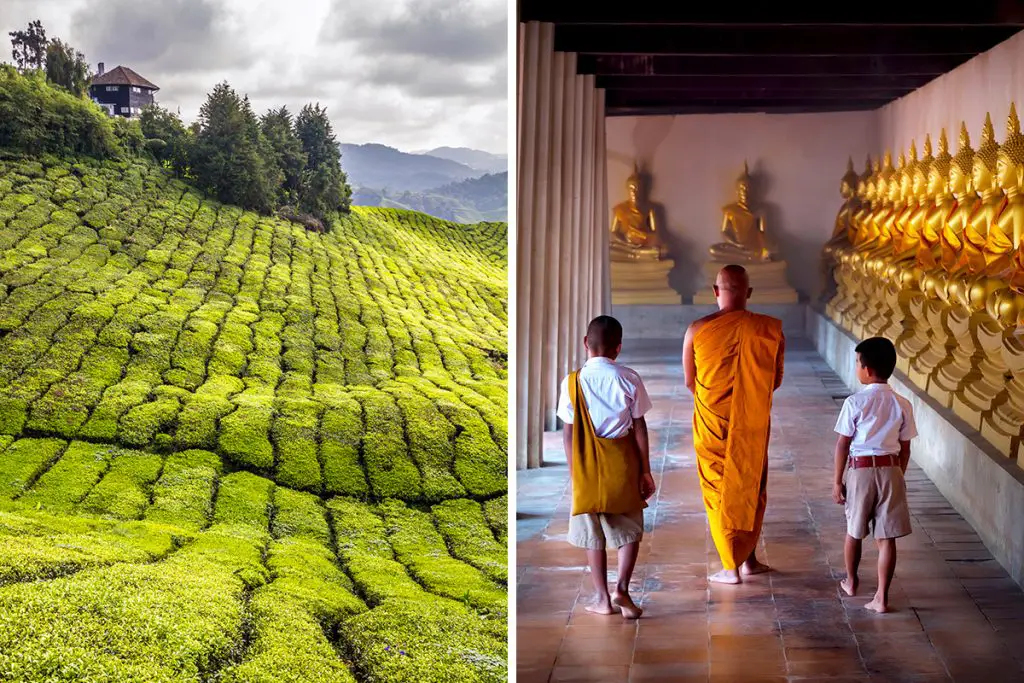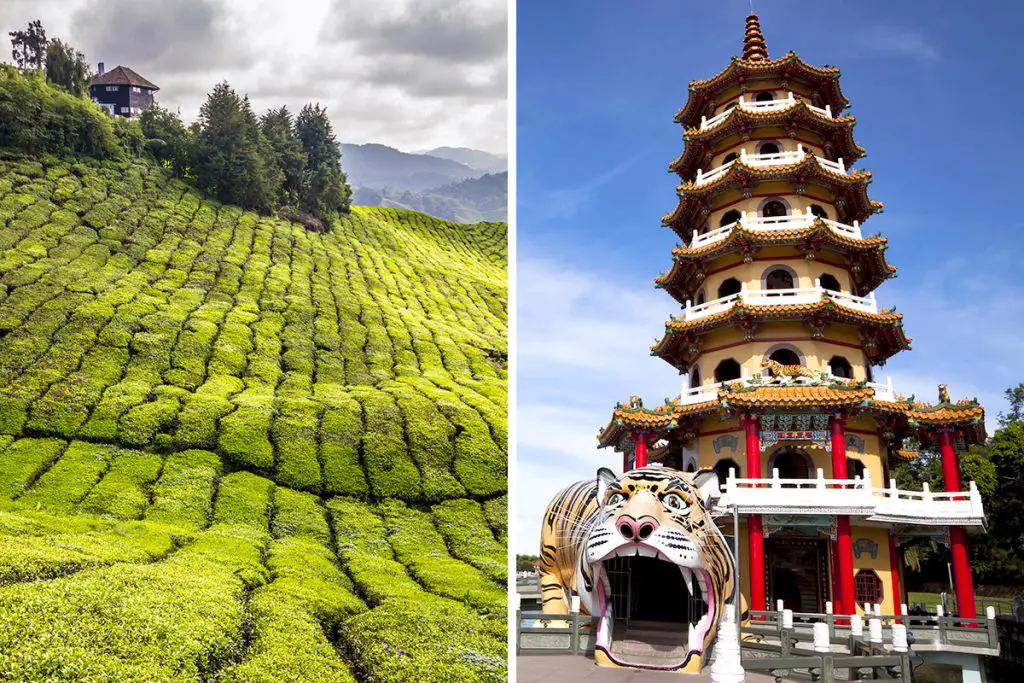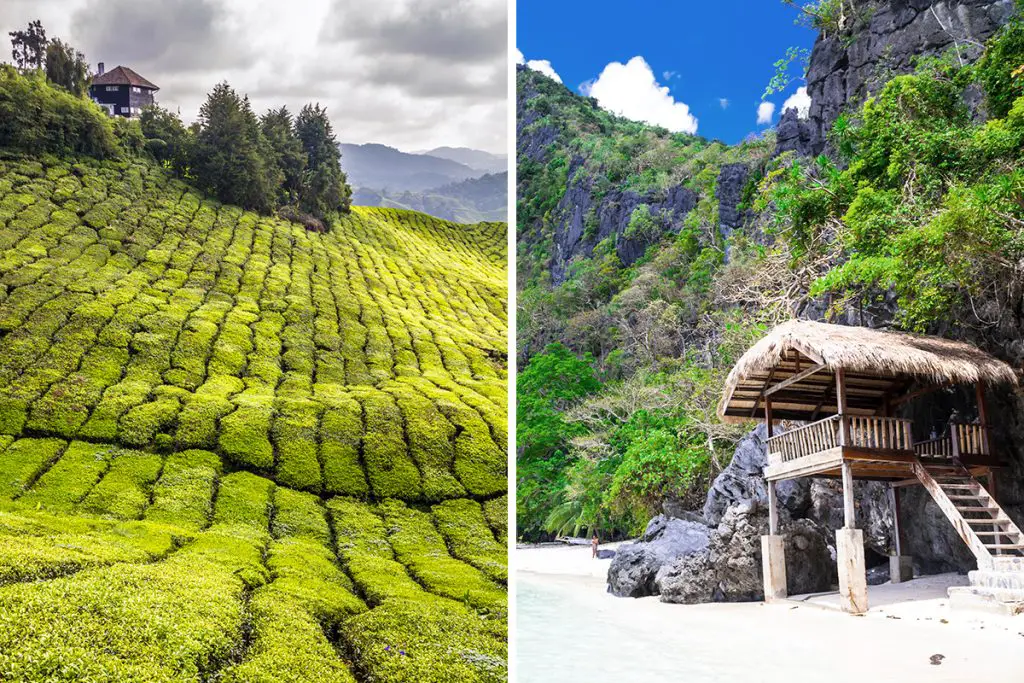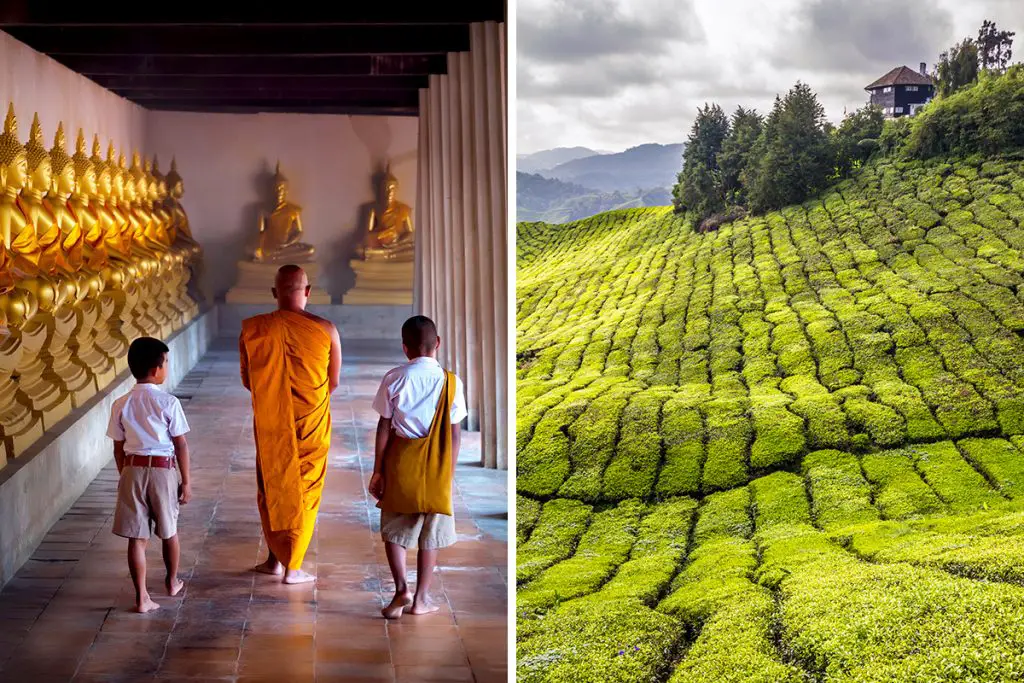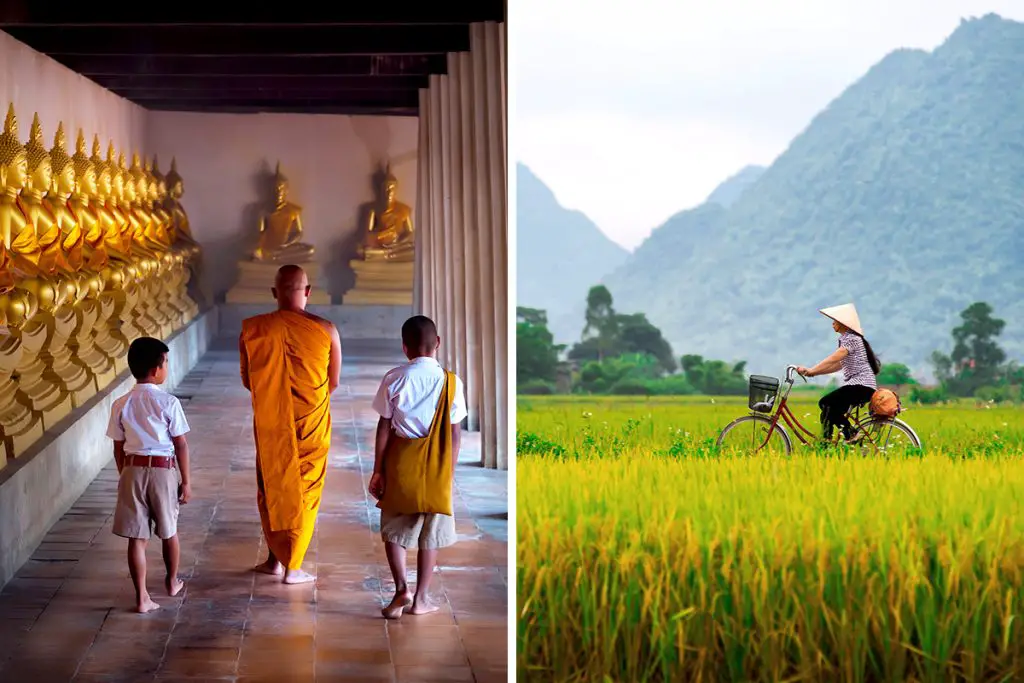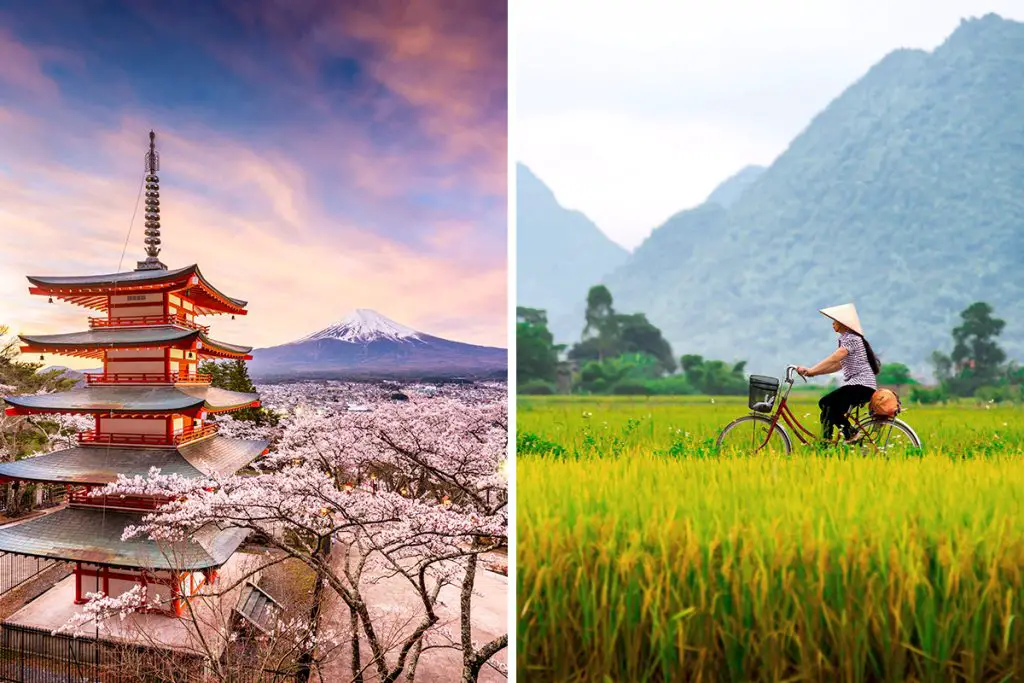Each destination has its unique charm and allure. Malaysia’s multicultural tapestry captivates travelers, while Vietnam’s deep-rooted history beckons. Your heart might already be leaning toward one, but your mind craves to know more. So, why not dive in? Discover the essence of these two fascinating countries in our in-depth comparison below.
History & Culture
Choosing a vacation destination often extends beyond beaches and amenities; the history and culture of a place can provide a fulfilling experience. So, let’s plunge into the history and culture of Malaysia and Vietnam to help you make an informed decision.
In Malaysia, a melting pot of cultures defines the nation. Influences from China, India, and native Malay traditions have blended to create a society that values harmony and diversity. Festivals like Diwali and Chinese New Year are celebrated with zest, and the multicultural environment is palpable in every corner.
The country has a constitutional monarchy, and the royal families are highly respected. Indigenous cultures like the Orang Asli also contribute to the cultural richness.
On the flip side, Vietnam’s history is deeply tied to its struggles for independence.
The country carries scars and stories of various occupations, most notably French colonialism and the Vietnam War. But don’t let that fool you. Vietnam has a resilient culture, influenced by Chinese Confucianism and local traditions. Various dynasties have left their mark, and the culture is rich in folklore, poetry, and arts.
When it comes to religious practices, Malaysia predominantly leans towards Islam, but you’ll also find Buddhism, Hinduism, and Christianity. In Vietnam, although a large section identifies as non-religious, you’ll find elements of Buddhism, Confucianism, and Taoism.
If you value arts and crafts, Malaysia showcases a variety of forms such as batik painting and kite-making. Vietnam also has a robust tradition in arts, including water puppetry and lacquerware.
In summary, if a multicultural atmosphere makes your heart sing, Malaysia might be your go-to place. But if a deeper, historical narrative with layers of resilience interests you, Vietnam should be on your radar. Both countries offer an enriching cultural experience that’s sure to leave a lasting impression. So, what stories do you want to become a part of on your next journey?
Attractions & Activities
Your trip can be as memorable as the adventures you embark on. Malaysia and Vietnam, both brimming with extraordinary attractions and activities, offer unique experiences that go beyond typical touristy pursuits. So, how do the two stack up against each other?
In Malaysia, nature enthusiasts should make a beeline for the Cameron Highlands. Located about 200 kilometers (about 124 miles) north of Kuala Lumpur, this hill station offers tea plantations, strawberry farms, and cool weather.
Then there’s the Batu Caves, a series of limestone caves hosting Hindu temples, just 13 kilometers (about 8 miles) north of Kuala Lumpur. Don’t miss out on the 272-step climb that takes you to breathtaking panoramic views.
Vietnam, on the other hand, offers the surreal Halong Bay. Picture yourself cruising through towering limestone pillars and lush greenery. This UNESCO World Heritage Site is about 170 kilometers (about 105 miles) east of Hanoi.
For history buffs, the Cu Chi Tunnels, around 55 kilometers (about 34 miles) from Ho Chi Minh City, offer an eye-opening glimpse into the Vietnam War. You can actually crawl through some of these underground tunnels!
Adrenaline junkies would love the Kinabalu Park in Malaysia. It’s home to Mount Kinabalu, Southeast Asia’s highest peak, standing at 4,095 meters (about 13,435 feet). Climbing the mountain is a rite of passage for many.
In Vietnam, Phong Nha-Ke Bang National Park offers adventurous cave explorations. The park contains the world’s largest cave, Son Doong, which has its own climate and ecosystems.
In conclusion, both Malaysia and Vietnam offer an array of captivating attractions and activities that cater to diverse interests. Whether it’s high-altitude climbs or exploring underground labyrinths, both countries serve up experiences that will ignite your curiosity and sense of adventure. The choice between the two would depend on what you seek—cultural enrichment, nature’s splendor, or a bit of both?
Beaches
A beach holiday is often synonymous with relaxation and rejuvenation. Malaysia and Vietnam, both blessed with stunning coastlines, offer their own distinctive beach experiences. What kind of sandy retreat are you looking for?
Malaysia’s Langkawi Island, located about 30 kilometers (about 18.6 miles) from the mainland, is a haven for beach lovers. Its famous Pantai Cenang stretches over 2 kilometers (about 1.2 miles) and offers golden sands alongside luxury resorts. On the east coast, you have the Perhentian Islands, ideal for snorkeling and diving activities.
Vietnam’s Phu Quoc Island, roughly 45 kilometers (about 28 miles) from the mainland, offers pristine beaches like Sao Beach. The white sands and turquoise waters make it an Instagram-worthy spot. Another highlight is Nha Trang, well-known for its water sports like jet skiing and parasailing.
In Malaysia, you also have the option of Sipadan Island, world-renowned for its diving spots. Located about 35 kilometers (about 21.7 miles) off the coast of Sabah, it’s teeming with rich marine biodiversity.
Meanwhile, Vietnam offers Con Dao Islands, about 230 kilometers (about 143 miles) from Ho Chi Minh City. These islands provide unique snorkeling experiences, as you get to explore coral reefs and even old shipwrecks.
Summing up, the beaches in Malaysia and Vietnam have their unique characteristics and offerings. Whether you’re looking for a quiet retreat in Langkawi or an adventurous day in Nha Trang, both countries have something special for you. Ultimately, your beachside dream could come true in either of these fantastic destinations.
Eating, Drinking & Nightlife
The culinary scene and nightlife can be the soul of any vacation. Both Malaysia and Vietnam offer their own distinct flavors, beverages, and after-dark experiences. So, which destination will satiate your appetite and quench your thirst for fun?
In Malaysia, your taste buds are in for a treat with dishes like Nasi Lemak, a flavorful rice dish cooked in coconut milk, and Satay, skewered and grilled meat served with peanut sauce. The food is a blend of Malay, Chinese, and Indian influences, offering a plethora of flavors in every bite. Street food stalls in cities like Kuala Lumpur and Penang are must-visit spots.
Vietnam, too, is a food lover’s paradise but in a different way. Think Pho, a sumptuous noodle soup, and Banh Mi, a Vietnamese sandwich that is a legacy of French colonialism. Seafood is abundant, especially in coastal towns like Da Nang and Nha Trang. The food often features fresh herbs and is less spicy compared to Malaysian cuisine.
When it comes to drinking, Malaysia offers an array of tropical fruit juices, but alcohol is less prevalent due to Islamic laws. However, you can still find bars and pubs in bigger cities. Vietnam has its own famous beer culture, with local favorites like Bia Hoi being extremely affordable. Coffee is also big in Vietnam; don’t miss trying the unique egg coffee in Hanoi.
As for nightlife, Malaysia has its trendy rooftop bars and clubs, particularly in Kuala Lumpur. Live music scenes are common, and the atmosphere is generally laid-back. Vietnam’s nightlife is vibrant and ranges from night markets to bustling bars and nightclubs, especially in cities like Ho Chi Minh City.
In summary, if your palate leans toward a mix of sweet, spicy, and tangy flavors, Malaysia could be your food haven. Vietnam will win you over if you’re keen on fresh, herbaceous cuisine. For nightlife and drinking, Vietnam offers a livelier scene, while Malaysia provides a more subdued, yet elegant, atmosphere.
Shopping
Shopping can be an adventure all on its own, and both Malaysia and Vietnam offer their own set of treasures. Whether you’re looking for high-end brands or unique local crafts, each destination has something special for you.
Malaysia’s Kuala Lumpur is home to mega-malls like the Suria KLCC and Pavilion, where you can find everything from luxury brands to tech gadgets. For more local flavors, check out the Central Market, which offers hand-crafted souvenirs and local art pieces. Don’t forget to bargain!
Vietnam’s shopping scene is slightly different. Hanoi’s Old Quarter and Ho Chi Minh City’s Ben Thanh Market offer a range of local products, including silk, bamboo goods, and traditional Vietnamese hats known as “Non La”. You’ll also find specialized streets in Hanoi where each lane is dedicated to a specific item like shoes, silk, or even tombstones.
If you’re into antiques, Malaysia has various stores in Malacca and Penang where you can find Southeast Asian artifacts and colonial-era finds. Vietnam offers antique shops primarily in Hanoi and Ho Chi Minh City but remember to check for authenticity.
Craftsmanship is another shopping highlight. In Malaysia, you’ll find beautiful pewter goods, while Vietnam is known for its intricate lacquerware and hand-embroidered items.
To sum up, if brand shopping and a mix of modern and traditional items excite you, Malaysia is the place to be. If you are more into local crafts and unique, street-market finds, Vietnam should be your pick. Each country offers a distinct shopping experience, making both destinations equally compelling for retail adventurers.
Accommodation
Where you lay your head at night is a big part of any travel experience. Both Malaysia and Vietnam offer a rich array of lodging options, each with its own unique touch. But how do these two destinations stack up when it comes to accommodation?
In Malaysia, you’ll find an eclectic mix of options, from traditional wooden houses known as “kampung” in rural areas to ultra-modern skyscraper hotels in Kuala Lumpur. Langkawi and the Cameron Highlands feature beautiful resorts, often surrounded by nature, perfect for a tranquil escape.
Vietnam also delivers a variety of accommodations. For instance, in Hanoi and Ho Chi Minh City, boutique hotels with French colonial architecture make for a nostalgic stay. In areas like Sapa and Halong Bay, you can opt for unique experiences like homestays with local tribes or even floating hotels.
Malaysia tends to offer more in terms of large hotel chains and business-centric options, particularly in its capital city. These places often come with a range of amenities such as swimming pools, fitness centers, and even shopping arcades within the hotel complex.
Vietnam leans more toward independent, boutique-style hotels, especially in historic towns like Hoi An and Hue. These are often smaller establishments that provide a more personalized experience, often with local crafts and textiles adorning the rooms.
In summary, both countries offer distinct lodging experiences. If you’re after big-city luxury or resorts nestled in nature, Malaysia has you covered. For more localized and unique stays, Vietnam could be your choice.
Family-Friendliness & Children’s Activities
Traveling with family adds another layer of consideration to your planning. Malaysia and Vietnam both offer compelling options for families, each with a unique twist on activities that captivate both young and old.
In Malaysia, you can visit places like Kuala Lumpur’s Petrosains Discovery Centre, a hands-on science museum that’s both educational and entertaining. Parks such as the Langkawi Wildlife Park offer interactive experiences with animals, making it a hit among kids.
Vietnam provides its own version of family fun. Consider a leisurely boat ride down the Mekong Delta, where kids can see traditional floating markets and engage with local communities. Also, interactive museums like the Ho Chi Minh City Museum of Fine Arts offer workshops for kids to get hands-on with art.
Outdoor activities are plentiful in both countries. Malaysia has Legoland, where families can spend an entire day exploring the various themed areas and rides. Vietnam offers nature-based activities like hiking in Sapa, a town nestled among rice terraces and mountains, which can be an educational and bonding experience for the family.
In the realm of entertainment, Malaysia boasts extravagant shows like the cultural dance performances in Sarawak Cultural Village. Vietnam counters with its traditional water puppet shows, a unique form of storytelling that is both captivating and cultural.
Summing up, Malaysia and Vietnam offer a range of family-friendly activities. Whether it’s interactive museums in Malaysia or nature-oriented adventures in Vietnam, both destinations make for a memorable family vacation.
Getting There & Getting Around
Access and mobility can greatly influence your travel experience. So how do Malaysia and Vietnam fare in terms of getting there and getting around?
To reach Malaysia, Kuala Lumpur International Airport serves as a major hub with numerous international flights. It’s located about 45 km (28 miles) south of Kuala Lumpur. Vietnam’s major airports include Tan Son Nhat International in Ho Chi Minh City and Noi Bai International in Hanoi, with similar global connections.
Once you’re in Malaysia, the public transportation system is quite efficient. Kuala Lumpur has an extensive metro system, the Light Rail Transit (LRT), that connects key parts of the city. Taxis and ride-sharing apps are also widely available.
In Vietnam, you can use the public bus system, but it’s less extensive compared to Malaysia. However, one of the most popular modes of travel is by motorbike taxis, locally known as “xe om.” Cycling is also a popular way to explore smaller cities like Hoi An.
Trains are another option in both countries. Malaysia’s railway network is more modern and includes high-speed trains that link major cities. Vietnam’s Reunification Express travels the length of the country, offering scenic coastal views, although it is slower.
In conclusion, both Malaysia and Vietnam offer convenient ways to arrive and move around. While Malaysia excels in organized public transport options like trains and metros, Vietnam gives you a more rustic and localized experience. Either way, you’ll find it easy to explore what each country has to offer.
Weather
Weather can be a deal-breaker or a dream-maker when it comes to vacation planning. So, how do Malaysia and Vietnam stack up in terms of climate? Let’s dive into the specifics.
Malaysia experiences a tropical rainforest climate, which means it’s warm and humid year-round. Temperatures typically range from 77°F to 95°F (25°C to 35°C). Rainfall is frequent, especially from November to March, during the northeast monsoon season. If you prefer less rain, consider visiting between May and September.
Vietnam, on the other hand, has a more diverse climate due to its length from north to south. In Hanoi, the north experiences four seasons, with colder weather from December to February where temperatures can drop to 57°F (14°C). Ho Chi Minh City in the south stays warm throughout the year, with temperatures around 75°F to 89°F (24°C to 32°C). For beach trips, May to October can be an excellent period but expect some rain.
The central part of Vietnam, including Da Nang and Hoi An, experiences heavy rainfall from September to January. Conversely, the dry season from February to July sees more tourists and more sun.
In summary, both countries offer different weather experiences. Malaysia is generally more consistent with its tropical climate, while Vietnam offers a more varied weather pattern depending on the region. Your ideal time to visit would depend on your weather preferences.
Safety
When you’re far from home, feeling secure can make all the difference. How do Malaysia and Vietnam compare when it comes to safety?
In general, Malaysia has a good reputation for safety. Violent crimes are relatively rare, especially against tourists. Petty crime like pickpocketing can occur in crowded places like markets, so vigilance is advised.
Vietnam also fares well in the safety department. Violent crime is uncommon, but scams and pickpocketing can happen, particularly in busy tourist spots. It’s advisable to keep an eye on your belongings.
When it comes to unique non-crime topics, Malaysia experiences occasional haze due to forest fires, mainly from late summer to early autumn. In Vietnam, street traffic can be hectic, and crossing the road can feel like a challenge for newcomers.
In summary, both Malaysia and Vietnam are relatively safe countries to visit. While petty crimes can happen, simple precautions will go a long way. Other concerns like air quality in Malaysia or navigating traffic in Vietnam are manageable and shouldn’t deter you from visiting.
Cost
A trip’s price tag can often dictate the ‘where’ and ‘how’ of your travel plans. So, how do Malaysia and Vietnam compare when it comes to cost?
In Malaysia, you can expect to pay around 12 Malaysian Ringgit (approximately 2.50 US dollars) for a local meal. Taxis are generally flagged for 4 Ringgit (approximately 1 US dollar). Accommodations vary widely, but a decent hotel room could set you back around 70 US dollars.
Vietnam is often considered one of the most budget-friendly countries in Asia. A meal at a local restaurant might cost around 50,000 Vietnamese Dong (approximately 2 US dollars). Taxis are flagged at around 15,000 Dong (less than 1 US dollar). For accommodations, a standard hotel room can average 150 US dollars.
In summary, both Malaysia and Vietnam offer excellent value for money but in different ways. Malaysia provides a broader range of options and is cheaper by just a smidge. Your choice will depend on what kind of experience and comfort level you’re seeking.
Which Is Better – Malaysia or Vietnam?
You’ve been on a journey exploring the intricate facets of two captivating destinations: Malaysia and Vietnam. Now comes the million-dollar question: Which destination is the better choice for you? Let’s sum up the key points from each section to make that decision a bit easier.
In terms of history and culture, Malaysia offers a melting pot of influences, from native traditions to colonial legacies. Vietnam, on the other hand, provides a deep dive into ancient history and a culture largely influenced by Chinese and French colonization.
If you’re an enthusiast of diverse, multicultural experiences, Malaysia has a slight edge. However, if you’re keen on exploring deep-rooted traditions and a more homogeneous cultural landscape, Vietnam calls your name.
When it comes to attractions and activities, Malaysia offers a blend of modernity and nature with its skyscrapers and rainforests. Vietnam focuses more on historical landmarks and scenic landscapes. If modern comforts blended with nature appeal to you, Malaysia is the pick. For the history buffs and nature lovers, Vietnam will not disappoint.
For beach lovers, both countries have much to offer, but their geographical differences make for unique experiences. Malaysia’s beaches are well-suited for those looking for a more consistent tropical environment.
Vietnam’s coastline, however, varies from north to south, offering more seasonal options. Your choice depends on your flexibility and what kind of beach vibe you’re after.
Eating, drinking, and nightlife? Malaysia has a wider variety of flavors due to its diverse culture, while Vietnam offers a more street food-centered and localized experience. If you’re a foodie looking for variety, Malaysia wins. But if you’re after authenticity and local flavors, Vietnam takes the cake.
Shopping opportunities abound in both nations. Malaysia leans more towards modern shopping malls, while Vietnam offers more in the way of traditional markets and handicrafts. Your shopping preferences dictate your choice here.
Finally, let’s talk about practicalities like accommodations, family-friendliness, getting there and around, weather, safety, and cost. Malaysia generally offers a broader range of options, making it easier for families and those looking for more amenities. Vietnam might be the better option if you’re open to a more local experience.
So, when should you pick Malaysia, and when is Vietnam the better choice? Choose Malaysia if you crave a multicultural experience, modern attractions, diverse culinary options, and a more convenient journey. Opt for Vietnam if you’re looking for deep cultural immersion and a more adventurous travel experience. Your ideal destination awaits!


